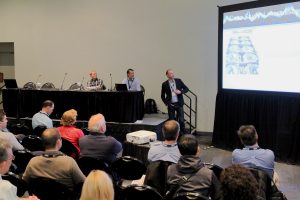AES 2018 Highlights Product Development, Marketing
Story Highlights
Audio product research and development are among the leading factors driving the field of audio engineering innovation, and, as in recent years, the AES Convention’s Product Development Track offered four full days of Technical Program workshops reflecting the state of innovation in audio. This year’s theme “Make Audio Matter” provided focus on the importance of audio across several industries and disciplines, and a showcase for the science and magic of what goes into great products. These sessions, open to AES New York 2018 All Access attendees at the Jacob Javits Center in New York City, October 17 – 20, hosted an eager audience of those wishing to expand their knowledge in these areas.
 “This year marks the fifth anniversary of the Product Development Track at AES…. an education track targeted at the audio product development community,” states Scott Leslie, AES New York 2018 Product Development Track Chair. “Our goal from the beginning was to help design-engineers, product managers, engineering leadership, supply chain professionals, and others to become more successful in bringing great products to market.”
“This year marks the fifth anniversary of the Product Development Track at AES…. an education track targeted at the audio product development community,” states Scott Leslie, AES New York 2018 Product Development Track Chair. “Our goal from the beginning was to help design-engineers, product managers, engineering leadership, supply chain professionals, and others to become more successful in bringing great products to market.”
“Each year the Product Development Track has a theme, and this year it was ‘Make Audio Matter,’” Leslie continues. “We had workshops that addressed both sides of ‘matter,’ as in both ‘Where can we make audio more important in any product,’ and ‘what is the “atomic” matter that goes into products today?’ We had two sessions this year led by Mike Klasco, including ‘Next Generation Materials for Audio Products.’ Deep learning was another type of ‘matter’ in two workshops presented on DSP Friday, both standing-room-only. Also on Friday, we had Paul Beckman’s workshop on the topic ‘Voice Input: What Is the Magic and What’s Next?,’ which addressed the hottest segment in audio products today – the conveniences offered by the likes of Amazon Alexa, Google Home, and Microsoft Cortana-based products.”
The Product Development Track at AES Conventions is committed to addressing all areas of product development. This year’s program included sessions on Product Development methods, legal topics, product quality and more. New technologies in loudspeaker processing, Bluetooth and acoustic measurements were also presented. Additionally, Dr. Wolfgang Klippel‘s session on hardware and software in modern loudspeakers gave a glimpse at the future of loudspeaker design.
Audio hardware engineer Ananth Raghavendra commented on his experience at the AES New York Convention: “The Product Development Track organized this year at AES New York was highly insightful and practically useful to me, as I work in audio hardware development. Some key topics I found extremely useful were ‘Power Amplification for High-Resolution Audio’ by John Dawson, ‘Audio Weaver usage in microphone and playback paths’ from Beckmann, all of Klippel’s talks and the glimpse into advancements in material science by Klasco. The insightful component I got out of it all was the one-on-one conversations between the audience and speakers, in addition to the slides presented. When this is organized again next year, I will definitely be there! AES’s Technical Program in general is a great place to learn if you are even marginally working in audio. You will surround yourself with sheer brilliance and realize that there is way more to learn and enjoy as you attend every year!”
“We have been working hard to broaden our audience reach, and this year we had workshops covering the consumer, automotive and pro products segments,” Leslie adds. “There is an ever-growing number of product development professionals in the audio world today, and we strive to make AES Product Development Track at our conventions the destination for learning, participating and networking for all of them. This year we had more audience participation than ever, thanks in part to our very popular interactive workshop format, which resulted in energetic discussions into the depth of the topics presented.”
